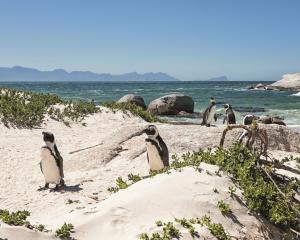First on our family's list to tick off was the Tongariro Crossing, rated as the best one-day trek in New Zealand and listed by many in the top 10 day treks in the world.
Numerous shuttles provide early morning pick-ups from National Park to transport walkers to the start of the 18.5km track at the Mangatepopo car park. We are eased into the trek with a gentle incline to Soda Springs, allowing us to enjoy the crisp clear morning in the valley punctuated with the crunching of the scoria track underfoot.
The track becomes a lunar landscape between the craters with wide open valleys creating an eerie sci-fi scene of walkers in ant-like proportions against the backdrop of mountains. A precarious descent from Red Crater to Blue Lake on loose scoria sliding like marbles underfoot makes us grateful we have a clear still day to walk the crossing; add in cloud and strong wind and this part would be very challenging.
The ever-changing scenery, dotted with intensely coloured mineral crater lakes and spectacular views over Mt Pihanga and Lake Rotoaira to Lake Taupo distracts me from my tiring muscles. The welcome descent from Ketetahi hut brings us back below the bush line and the variety of native plants multiply as we follow the Mangatetipua Stream to the car park at the end of the track. The shuttle bus awaits to return the weary walkers to National Park where we head into the backpackers to book our next adventure - canoeing the Whanganui River.
After yesterday's walk it is now time for an upper-body workout, with a day paddling the picturesque stretch of river between Taumarunui and Ohinepane. We hire a mix of open Canadian canoes and kayaks and load our picnic lunch into barrels before an on-river briefing with our guide.
After proving our proficiency in paddling the gentle rapids we are left to explore the river that was dubbed the Rhine of the South Pacific when the first Europeans ventured into this area.
Relationships are tested in the two-person canoes when the rapids get bigger and the adrenalin gets flowing. With the river running lower than normal, rocks seem to pop up from nowhere and one manages to catch the canoe and empty its contents, who fortunately follow the drill of holding on to the paddle and going feet-first down the rapids. Over this 21km stretch of river we tackle 49 rapids, while paddlers on the five-day expedition to Pipiriki will encounter around 250 named rapids.
On the bush-lined riverbank we spot a sign for Lauren's Lavender Farm, where we discover a tranquil oasis of heady scented lavender rows leading to a much-welcomed cafe. Recharged with coffee and carrot cake we paddle on to our pick-up point at Ohinepane to complete our action-packed weekend, feeling physically tired yet fully rejuvenated.
National Park may be in the middle of nowhere but it is definitely adventure central.
• Bev Bradford is a Queenstown travel writer.












